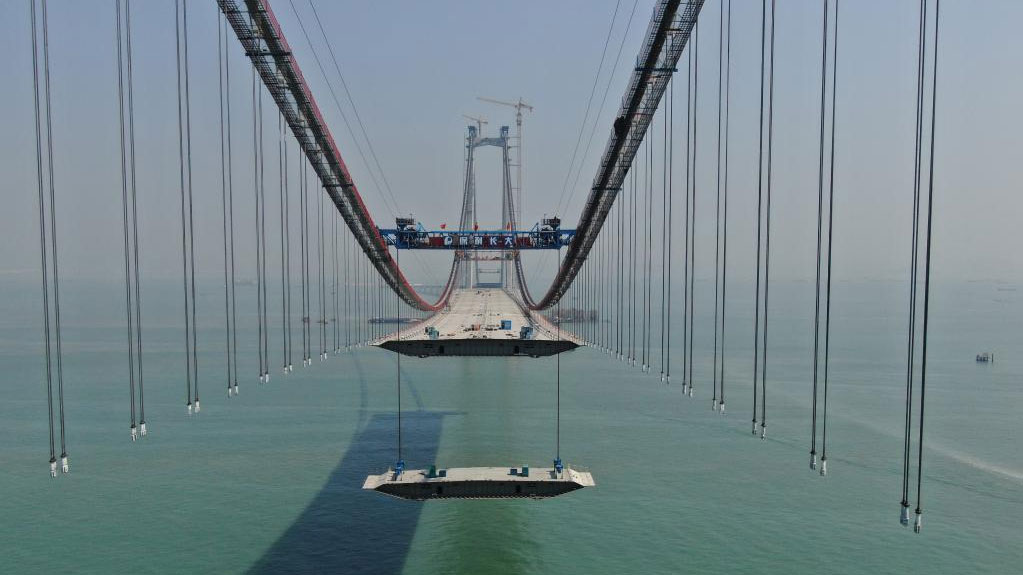Coordinated development deepens across Jing-Jin-Ji region in 9 years

Smart delivery robots work at the full Internet of Things container terminal of Tianjin Port in north China's Tianjin, Feb. 21, 2023. As the "maritime gateway" to the Beijing-Tianjin-Hebei region, Tianjin Port has been ceaselessly advancing the construction of a smart port, boosting the coordinated development of the region with fresh impetus.(Photo: Xinhua)
China's coordinated development of Beijing, North China's Tianjin Municipality and Hebei Province - a regional city cluster called Beijing-Tianjin-Hebei, with its conveniently shortened form "Jing-Jin-Ji" - witnessed its ninth anniversary on Sunday.
Over the nine years, remarkable achievements have been made in the key fields of industrial upgrading, traffic management and environmental protection, bringing the region's total GDP to 10 trillion yuan ($1.44 trillion) in 2022, up 1.8 times compared with the figure in 2013.
In February 2014, China initiated a key strategy to coordinate the development of Beijing, Tianjin and Hebei to create a model with a better economic structure, cleaner environment and improved public services.
A prominent task of the strategy is to move non-capital functions out of Beijing to treat "urban ills" such as traffic jams and pollution in the Chinese capital. Approximately 3,000 manufacturing and polluting enterprises in Beijing have been shut down, and nearly 1,000 markets and logistics centers have been relocated since 2014, according to data released by the Beijing Municipal Commission of Development Reform on Thursday.
Beijing's Zhongguancun, also known as China's Silicon Valley, is an important source of technological innovation in the Jing-Jin-Ji region. To date, enterprises based in Zhongguancun have set up more than 9,500 branches in Tianjin and Hebei. The total turnover of Beijing's technology contracts flowing to the two localities exceeded 210 billion yuan as of 2022, shows data from the commission.
Transportation development has been a basis for the coordinated development of the Jing-Jin-Ji region. A "one-hour traffic circle" has now come into being among Beijing, Tianjin and some cities in Hebei.
On December 31, 2022, a new expressway between Beijing and Xiong'an New Area in Hebei Province opened to traffic, reducing travel time from 80 to 50 minutes.
According to data released by the Beijing Municipal Bureau of Statistics, the length of high-speed roads in the Jing-Jin-Ji region totaled 10,585.5 kilometers by the end of 2022, up 32.6 percent compared with the end of 2014, while the length of commercial railways totaled 10,848 kilometers by the end of 2022, up 38.3 percent compared with the end of 2014.
In addition, this coordinated development has also brought a cleaner and greener environment to people in the region. Last year, the average concentration of PM2.5, small particles of pollution, in Beijing, Tianjin and Hebei dropped over 60 percent compared with 2013.
The Hebei provincial government recently held a meeting, pointing to stepped-up efforts in coordination with Beijing and Tianjin in railways, roads, ports and aviation to build the province's advantage in logistics globally, to become a core industrial hub and agricultural product base, while joining hands with Tianjin to build a port cluster around the Bohai Sea, according to a statement on the provincial government website on Saturday.
Tianjin municipal government vowed in a meeting on Saturday that it will convert the strategic advantage of coordinated development of the Jing-Jin-Ji region along with Tianjin's advantages in industry, technologies and ports to sustainable momentum of Tianjin's through goal-oriented and problem-oriented approaches, Chen Yao, secretary general of the China Association of Regional Economics, told the Global Times on Sunday.
"While coordinated development in the region was focused on tackling Beijing's 'urban ills' between 2013 and 2022, authorities will shift the focus to improving its overall competitiveness to form a world-class city cluster by 2030 as the central government has planned," Chen said.
Compared with urban clusters in the Yangtze River Delta and Guangdong-Hong Kong-Macao Greater Bay Area, there is bigger room to improve Jing-Jin-Ji's competitiveness, he told the Global Times.
According to Chen, the Jing-Jin-Ji region should continue to strengthen its connections in transport, information and other sectors to magnify the spillover effects of Beijing to drive industrial transformation and upgrading in Tianjin and Hebei Province, as well as increase innovation and industry coordination in the entire region.
By taking the opportunity of the high-quality integrated development of Beijing's Tongzhou district, and Sanhe, Dachang and Xianghe in Hebei, authorities should actively explore a path toward coordination in areas like city planning, public services and the business environment to build a new example for regional development in the new era, said Chen on Sunday.
Photos
Related Stories
- Beijing-Tianjin-Hebei region's coordinated development generates new growth driver
- Full Internet of Things container terminal of Tianjin Port
- China's Tianjin Municipality, Hong Kong ink 19 cooperation projects worth 2.2 bln USD
- China's Tianjin revs up foreign trade to fuel growth
- Beijing unveils blueprint to boost museum construction
- China's Tianjin notches double-digit growth in actual use of foreign investment
- 36 manufacturing projects signed in China's Tianjin
- Snow scenery of Jiankou section of Great Wall in Beijing
- Glasswork making industry booms in Hejian, N China
- Tianjin Municipality announces 673 key construction projects in 2023
Copyright © 2023 People's Daily Online. All Rights Reserved.









